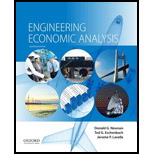
(a)
The prospective
Answer to Problem 14P
The prospective rate of return before income tax is,
Explanation of Solution
Given:
Annual receipts is
Annual disbursements is
Total asset value is of
Life time is
Combined tax is
Calculation:
Calculate the net revenue.
Calculate rate of return before tax as shown below.
Here, initial investment is
Substitute
Look through the compound interest table to find the value of
| Interest rate | |
Table-(1)
The rate of return, which is between
Here, lower interest rate is
Substitute
Conclusion:
Therefore, the prospective rate of return before income tax is,
(b)
The prospective rate of return after income tax.
Answer to Problem 14P
The prospective rate of return after income tax is,
Explanation of Solution
Concept used:
Write the formula to calculate the taxable income.
Here, the taxable income is
Write the formula to calculate the taxable amount.
Here, the taxable amount is
Write the formula to calculate the after tax cash flow.
Here, the after tax cash flow is
Calculation:
Write the formula to calculate the straight line depreciation.
Here, the asset value is
Substitute
Calculate the After cash flow of as shown in table below.
| Year | BTCF | DI | TI | Tax | ATCF |
| - | |||||
Table-(2)
Calculate the rate of return after tax.
Substitute
Look through the compound interest table to find the value of
| Interest rate | |
| 5.81 | |
Table-(3)
The rate of return, which is between
Substitute
Conclusion:
Therefore, the prospective rate of return after income tax is,
(c)
The prospective rate of return after income tax.
Answer to Problem 14P
The prospective rate of return after income tax is
Explanation of Solution
Given:
The life time is
Calculation:
Write the expression to calculate the depreciation using Straight line depreciation method.
Here, asset value is
Substitute
Calculate the After cash flow of as shown in table below.
| Year | BTCF | DI | TI | Tax | ATCF |
Table-(4)
Calculate the rate of return after tax for
Calculate average ATCF for
Calculate average ATCF for
Substitute
Use the trial and error method to verify the interest rate.
Substitute rate of return to
The value is greater than
Substitute rate of return to
The value is lower than
The rate of return, which is between
Substitute
Conclusion:
Therefore, the prospective rate of return after income tax is,
Want to see more full solutions like this?
Chapter 12 Solutions
Engineering Economic Analysis

 Principles of Economics (12th Edition)EconomicsISBN:9780134078779Author:Karl E. Case, Ray C. Fair, Sharon E. OsterPublisher:PEARSON
Principles of Economics (12th Edition)EconomicsISBN:9780134078779Author:Karl E. Case, Ray C. Fair, Sharon E. OsterPublisher:PEARSON Engineering Economy (17th Edition)EconomicsISBN:9780134870069Author:William G. Sullivan, Elin M. Wicks, C. Patrick KoellingPublisher:PEARSON
Engineering Economy (17th Edition)EconomicsISBN:9780134870069Author:William G. Sullivan, Elin M. Wicks, C. Patrick KoellingPublisher:PEARSON Principles of Economics (MindTap Course List)EconomicsISBN:9781305585126Author:N. Gregory MankiwPublisher:Cengage Learning
Principles of Economics (MindTap Course List)EconomicsISBN:9781305585126Author:N. Gregory MankiwPublisher:Cengage Learning Managerial Economics: A Problem Solving ApproachEconomicsISBN:9781337106665Author:Luke M. Froeb, Brian T. McCann, Michael R. Ward, Mike ShorPublisher:Cengage Learning
Managerial Economics: A Problem Solving ApproachEconomicsISBN:9781337106665Author:Luke M. Froeb, Brian T. McCann, Michael R. Ward, Mike ShorPublisher:Cengage Learning Managerial Economics & Business Strategy (Mcgraw-...EconomicsISBN:9781259290619Author:Michael Baye, Jeff PrincePublisher:McGraw-Hill Education
Managerial Economics & Business Strategy (Mcgraw-...EconomicsISBN:9781259290619Author:Michael Baye, Jeff PrincePublisher:McGraw-Hill Education





